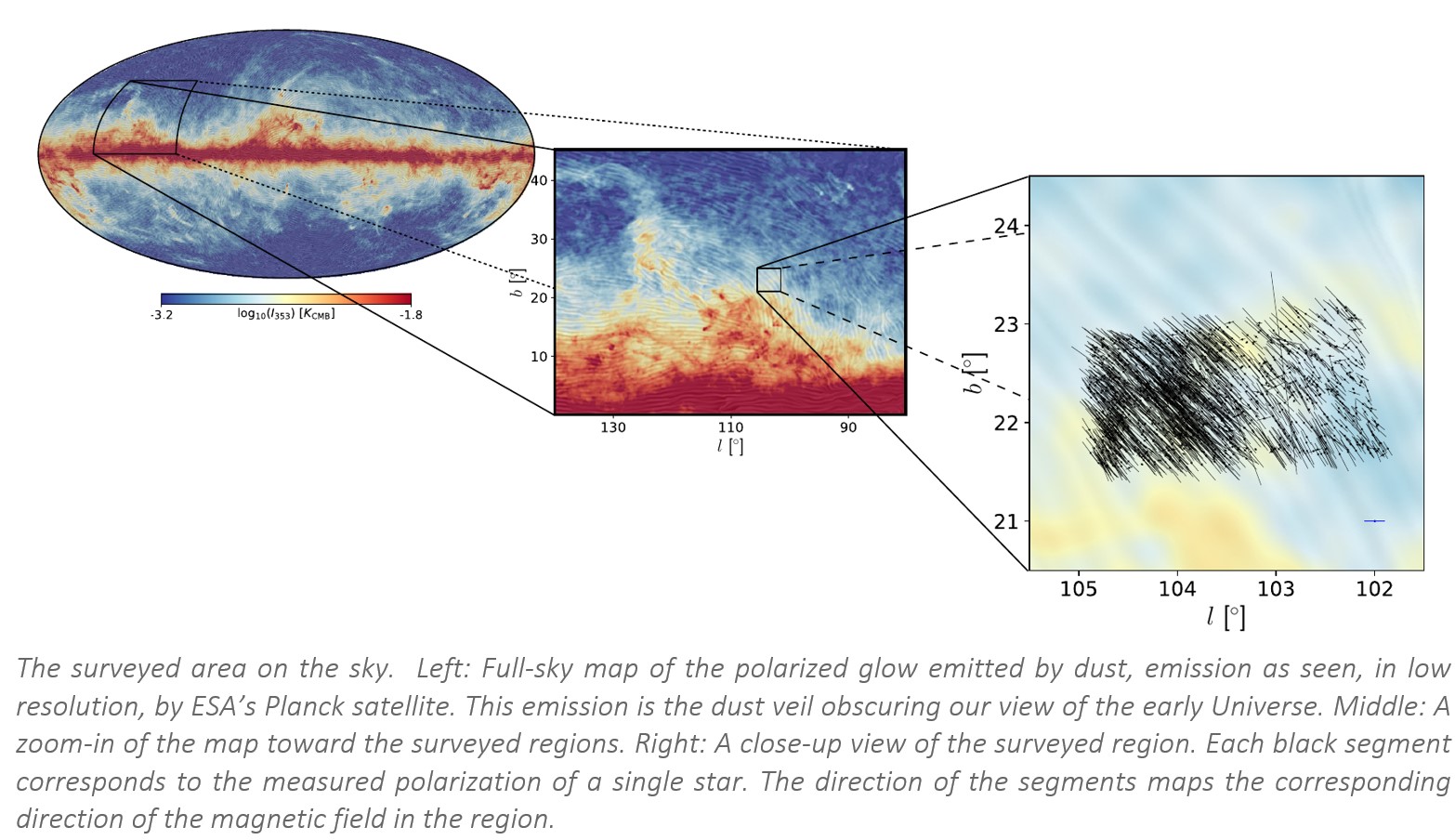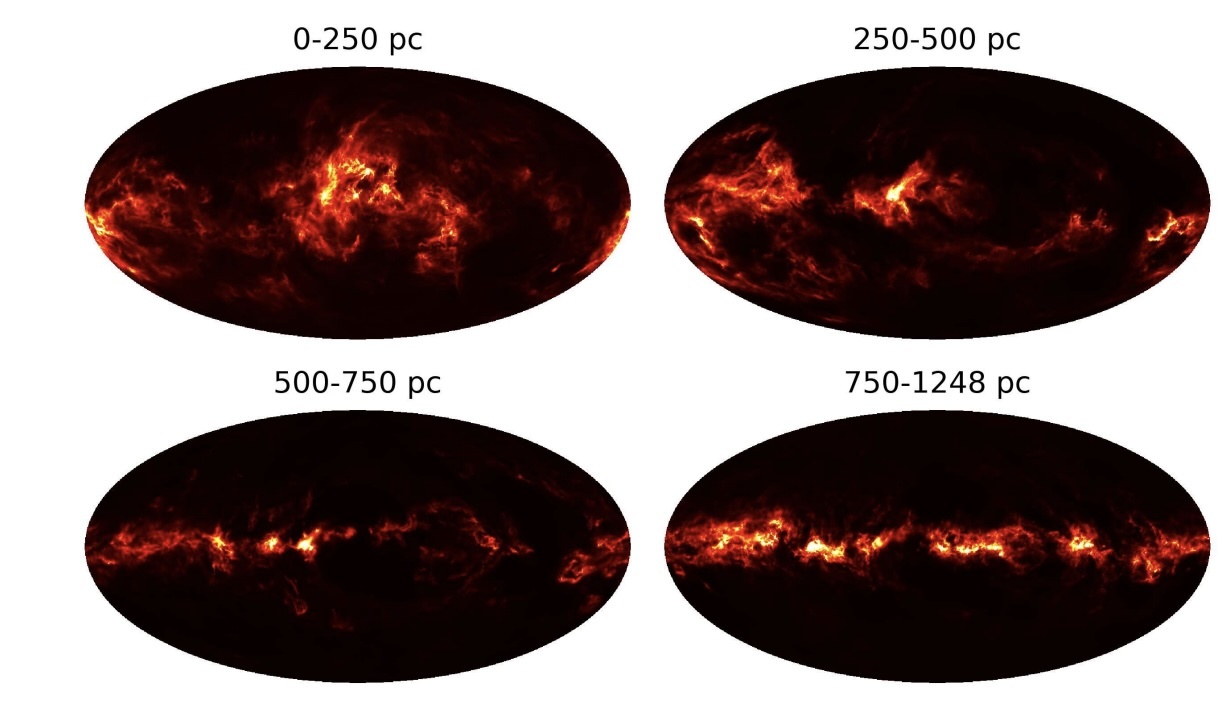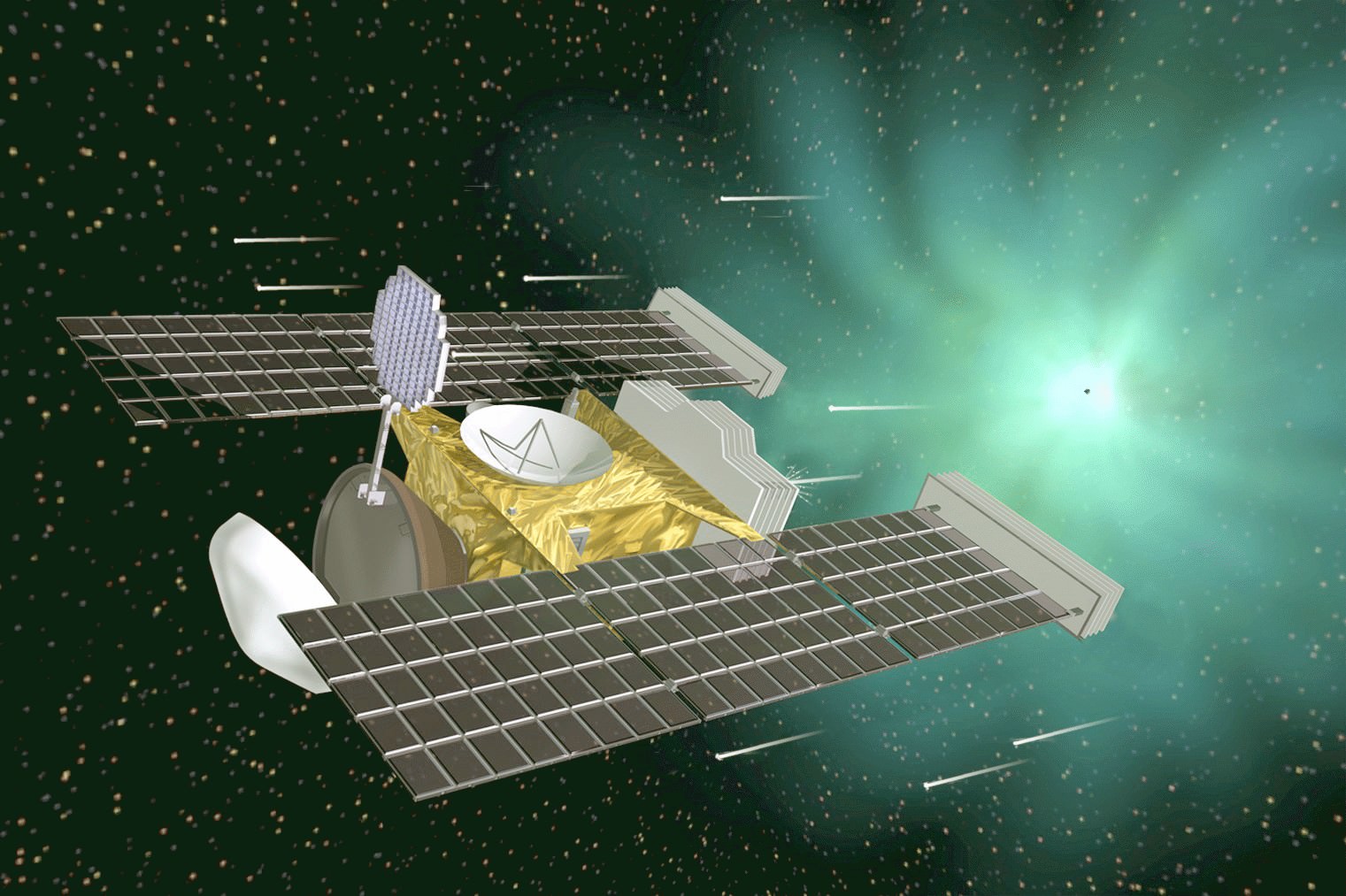We are all very familiar with the concept of the Earth’s magnetic field. It turns out that most objects in space have magnetic fields but it’s quite tricky to measure them. Astronomers have developed an ingenious way to measure the magnetic field of the Milky Way using polarised light from interstellar dust grains that align themselves to the magnetic field lines. A new survey has begun this mapping process and has mapped an area that covers the equivalent of 15 times the full Moon.
Continue reading “Mapping the Milky Way’s Magnetic Field in 3D”Astronomers Build a 3D Map of Dust Within Thousands of Light-Years
If you explore the night sky it won’t be long before you realise there is a lot of dust and gas up there. The interstellar dust between the stars accounts for 1% of the mass of the interstellar medium but reflects 30% of the starlight in infrared wavelengths. The dust plays a key role in the formation of stars and the evolution of the Galaxy. A team of astronomers have attempted to map the dust out to a distance of 3000 light years and have just released the first 3D map of the dust in our Galaxy.
Continue reading “Astronomers Build a 3D Map of Dust Within Thousands of Light-Years”Astronomers Have Found Grease in Space
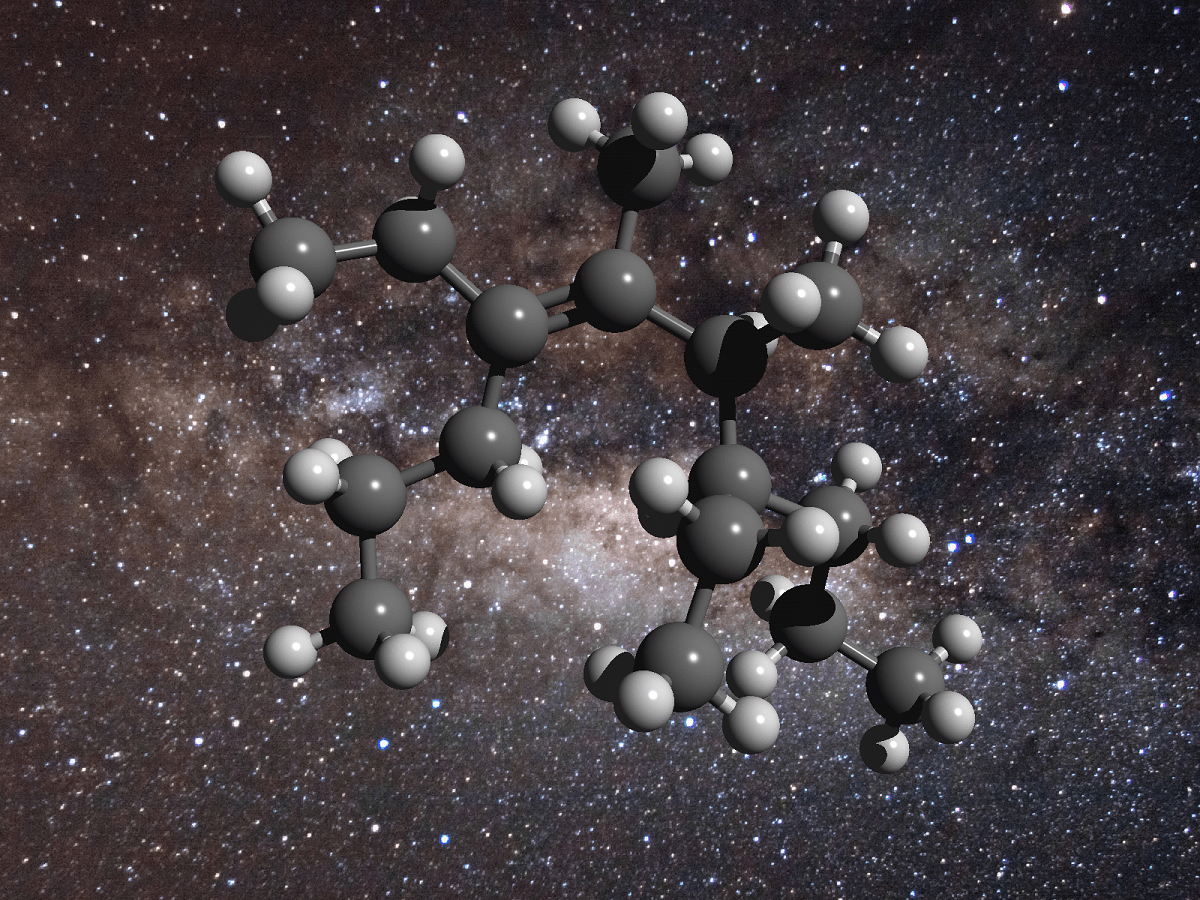
Over the course of many centuries, scientists learned a great deal about the types of conditions and elements that make life possible here on Earth. Thanks to the advent of modern astronomy, scientists have since learned that these elements are not only abundant in other star systems and parts of the galaxy, but also in the medium known as interstellar space.
Consider carbon, the element that is essential to all organic matter and life as we know it. This life-bearing element is also present in interstellar dust, though astronomers are not sure how abundant it is. According to new research by a team of astronomers from Australia and Turkey, much of the carbon in our galaxy exists in the form of grease-like molecules.
Their study, “Aliphatic Hydrocarbon Content of Interstellar Dust“, recently appeared in the Monthly Notices of the Royal Astronomical Society. The study was led by Gunay Banihan, a professor from the Department of Astronomy and Space Sciences of Erge University in Turkey, and included members from multiple departments from the University of New South Wales in Sydney (UNSW).
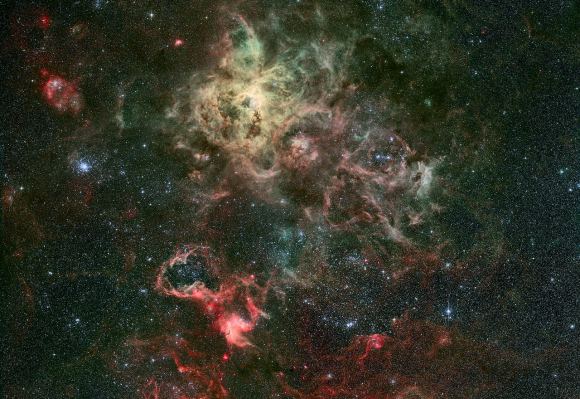
For the sake of their study, the team sought to determine exactly how much of our galaxy’s carbon is bound up in grease-like molecules. At present, it is believed that half of the interstellar carbon exists in pure form, whereas the rest in bound up in either grease-like aliphatic molecules (carbon atoms that form open chains) and mothball-like aromatic molecules (carbon atoms that form planar unsaturated rings).
To determine how plentiful grease-like molecules are compared to aromatic ones, the team created material with the same properties as interstellar dust in a laboratory. This consisted of recreating the process where aliphatic compounds are synthesized in the outflows of carbon stars. They then followed up on this by expanding the carbon-containing plasma into a vacuum at low temperatures to simulate interstellar space.
As Prof. Tim Schmidt, from the Australian Research Council Centre of Excellence in Exciton Science in the School of Chemistry at UNSW Sydney and a co-author on the paper, explained:
“Combining our lab results with observations from astronomical observatories allows us to measure the amount of aliphatic carbon between us and the stars.”
Using magnetic resonance and spectroscopy, they were then able to determine how strongly the material absorbed light with a certain infrared wavelength. From this, the team found that there are about 100 greasy carbon atoms for every million hydrogen atoms, which works out to about half of the available carbon between stars. Expanding that to include all of the Milky Way, they determined that about 10 billion trillion trillion tonnes of greasy matter exists.
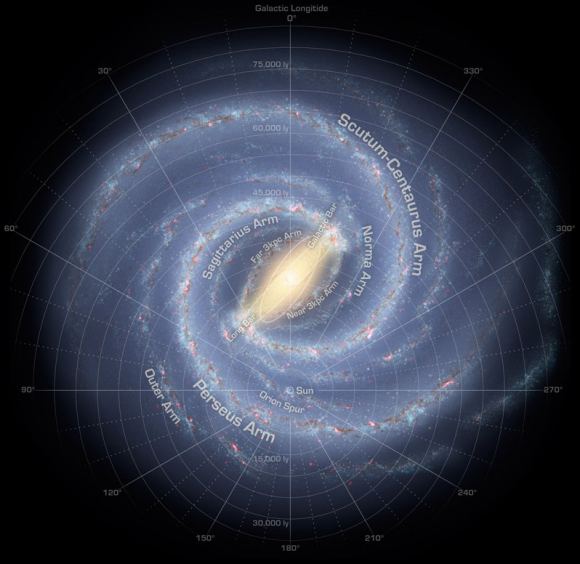
To put that in perspective, that’s enough grease to fill about 40 trillion trillion trillion packs of butter. But as Schmidt indicated, this grease is far from being edible.
“This space grease is not the kind of thing you’d want to spread on a slice of toast! It’s dirty, likely toxic and only forms in the environment of interstellar space (and our laboratory). It’s also intriguing that organic material of this kind – material that gets incorporated into planetary systems – is so abundant.”
Looking ahead, the team now wants to determine the abundance of the other type of non-pure carbon, which is the mothball-like aromatic molecules. Here too, the team will be recreating the molecules in a laboratory environment using simulations. By establishing the amount of each type of carbon in interstellar dust, they will be able to place constraints on how much of this elements is available in our galaxy.
This in turn will allow astronomers to determine exactly how much of this life-giving element is available, and could also help shed light on how and where life can take hold!
Galactic Panspermia: Interstellar Dust Could Transport Life from Star to Star

The theory of Panspermia states that life exists through the cosmos, and is distributed between planets, stars and even galaxies by asteroids, comets, meteors and planetoids. In this respect, life began on Earth about 4 billion years ago after microorganisms hitching a ride on space rocks landed on the surface. Over the years, considerable research has been devoted towards demonstrating that the various aspects of this theory work.
The latest comes from the University of Edinburgh, where Professor Arjun Berera offers another possible method for the transport of life-bearing molecules. According to his recent study, space dust that periodically comes into contact with Earth’s atmosphere could be what brought life to our world billions of years ago. If true, this same mechanism could be responsible for the distribution of life throughout the Universe.
For the sake of his study, which was recently published in Astrobiology under the title “Space Dust Collisions as a Planetary Escape Mechanism“, Prof. Berera examined the possibility that space dust could facilitate the escape of particles from Earth’s atmosphere. These include molecules that indicate the presence of life on Earth (aka. biosignatures), but also microbial life and molecules that are essential to life.

Fast-moving flows of interplanetary dust impact our atmosphere on a regular basis, at a rate of about 100,000 kg (110 tons) a day. This dust ranges in mass from 10-18 to 1 gram, and can reach speeds of 10 to 70 km/s (6.21 to 43.49 mps). As a result, this dust is capable of impacting Earth with enough energy to knock molecules out of the atmosphere and into space.
These molecules would consist largely of those that are present in the thermosphere. At this level, those particles would consist largely of chemically disassociated elements, such as molecular nitrogen and oxygen. But even at this high altitude, larger particles – such as those that are capable of harboring bacteria or organic molecules – have also been known to exist. As Dr. Berera states in his study:
“For particles that form the thermosphere or above or reach there from the ground, if they collide with this space dust, they can be displaced, altered in form or carried off by incoming space dust. This may have consequences for weather and wind, but most intriguing and the focus of this paper, is the possibility that such collisions can give particles in the atmosphere the necessary escape velocity and upward trajectory to escape Earth’s gravity.”
Of course, the process of molecules escaping our atmosphere presents certain difficulties. For starters, it requires that there be enough upward force that can accelerate these particles to escape velocity speeds. Second, if these particle are accelerated from too low an altitude (i.e. in the stratosphere or below), the atmospheric density will be high enough to create drag forces that will slow the upward-moving particles.
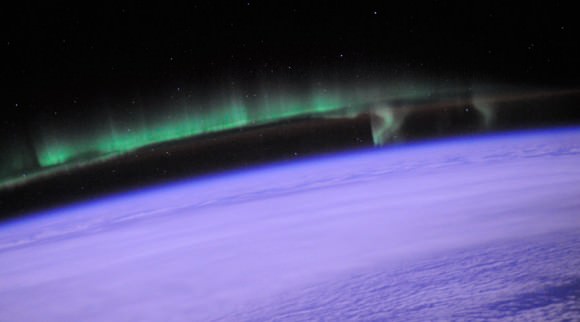
In addition, as a result of their fast upward travel, these particle would undergo immense heating to the point of evaporation. So while wind, lighting, volcanoes, etc. would be capable of imparting huge forces at lower altitudes, they would not be able to accelerate intact particles to the point where they could achieve escape velocity. On the other hand, in the upper part of the mesosphere and thermosphere, particles would not suffer much drag or heating.
As such, Berera concludes that only atoms and molecules that are already found in the higher atmosphere could be propelled into space by space dust collisions. The mechanism for propelling them there would likely consist of a double state approach, whereby they are first hurled into the lower thermosphere or higher by some mechanism and then propelled even harder by fast space dust collision.
After calculating the speed at which space dust impacts our atmosphere, Berera determined that molecules that exist at an altitude of 150 km (93 mi) or higher above Earth’s surface would be knocked beyond the limit of Earth’s gravity. These molecules would then be in near-Earth space, where they could be picked up by passing objects such as comets, asteroid or other Near-Earth Objects (NEO) and carried to other planets.
Naturally, this raises another all-important question, which is whether or not these organisms could survive in space. But as Berera notes, previous studies have borne out the ability of microbes to survive in space:
“Should some microbial particles manage the perilous journey upward and out of the Earth’s gravity, the question remains how well they will survive in the harsh environment of space. Bacterial spores have been left on the exterior of the International Space Station at altitude ~400km, in a near vacuum environment of space, where there is nearly no water, considerable radiation, and with temperatures ranging from 332K on the sun side to 252K on the shadow side, and have survived 1.5 years.”
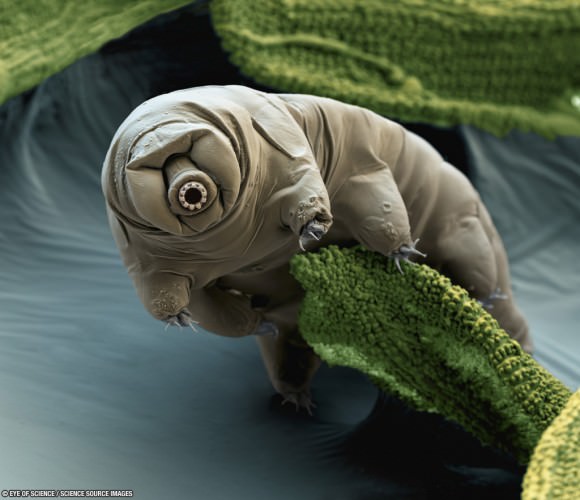
Another thing Berera considers is the strange case of tardigrades, the eight-legged micro-animals that are also known as “water bears”. Previous experiments have shown that this species is capable of surviving in space, being both strongly resistant to radiation and desiccation. So it is possible that such organisms, if they were knocked out of Earth’s upper atmosphere, could survive long enough to hitch a ride to another planet
“The proposition that space dust collisions could propel organisms over enormous distances between planets raises some exciting prospects of how life and the atmospheres of planets originated. The streaming of fast space dust is found throughout planetary systems and could be a common factor in proliferating life.”
In addition to offering a fresh take on Panspermia, Berera’s study is also significant when it comes to the study of how life evolved on Earth. If biological molecules and bacteria have been escaping Earth’s atmosphere continuously over the course of its existence, then this would suggest that it could still be floating out in the Solar System, possibly within comets and asteroids.
These biological samples, if they could be accessed and studied, would serve as a timeline for the evolution of microbial life on Earth. It’s also possible that Earth-borne bacteria survive today on other planets, possibly on Mars or other bodies where they locked away in permafrost or ice. These colonies would basically be time capsules, containing preserved life that could date back billions of years.
Further Reading: University of Edinburgh, Astrobiology
How A Comet-Chasing Spacecraft ‘Likely’ Brought Interstellar Dust Back To Earth
If the scientists are right, a NASA spacecraft brought stuff from outside the solar system back to Earth. The Stardust spacecraft, which was originally tasked with chasing after Comet Wild 2, brought our planet seven grains that look fluffier than expected.
While the scientists say that more tests are needed to determine these particles originated from outside the solar system, they are confident enough to publish a paper on the findings today.
“They are very precious particles,” stated Andrew Westphal, a physicist at the University of California, Berkeley’s space sciences laboratory who led 65 co-authors who created a paper on the research.
What’s more, the findings came with a big assist from volunteers who participated in a crowdsourced project to look at dust tracks in Stardust’s aerogel detector.
The Stardust spacecraft was launched in February 1999 to gather samples of Comet Wild 2 and return them to our planet. Stardust also attempted to collect interstellar dust twice in 2000 and 2002 for 195 days. Its mission was extended in 2011 to look at Comet Tempel-1, the comet that Deep Impact crashed into.
The sample return capsule, however, separated from the spacecraft in January 2006 as planned while Stardust flew by our planet, landing safely on Earth. Comet samples and interstellar samples were stored separately. Scientists then began the work of seeing what the spacecraft had picked up.
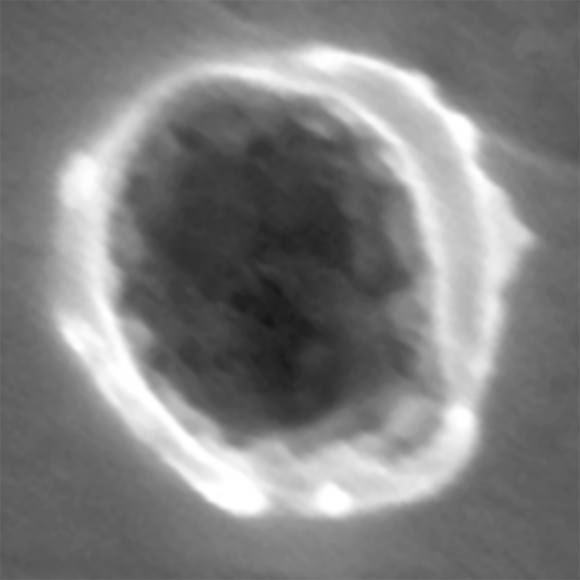
Here’s where the volunteers came in. These people, who called themselves “Dusters”, participated in a project called Stardust@home that put more than a million images online for people to examine.
Three particles, dubbed “Orion”, “Hylabrook” and “Sorok”, were found in the aerogel detectors after volunteers discovered their tracks. (Many more tracks were discovered, but only a handful led to dust. Also, 100 tracks and about half of the 132 aerogel panels still need to be analyzed.)
Four more particles were tracked down in aluminum foils between the aerogel tiles. That wasn’t originally where they were supposed to be collectors, but despite their “splatted” and melted appearance there was enough left for scientists to analyze. (About 95% of the foils still need to be examined.)
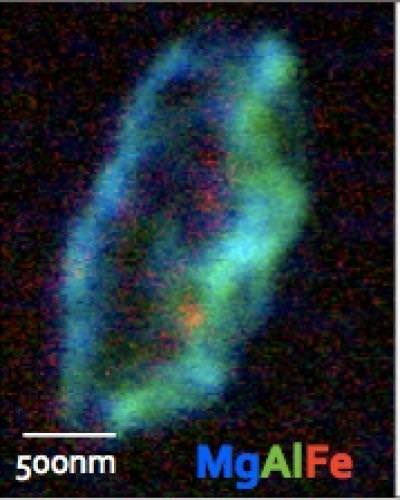
So what did the scientists see? They describe the particles as fluffy, sometimes appearing to come from a mix of particles. The largest ones included crystalline material called olivine (a magnesium-iron-silicate). More testing is planned to see what their abundances of different types of oxygen are, which could help better understand where they came from.
Additionally, three of the foil particles had sulfur compounds, which is controversial because some astronomers believe that isn’t possible in interstellar dust particles.
The research was published in the journal Science. Twelve more papers on Stardust will be published in Meteoritics & Planetary Science.
Sources: University of California – Berkeley

